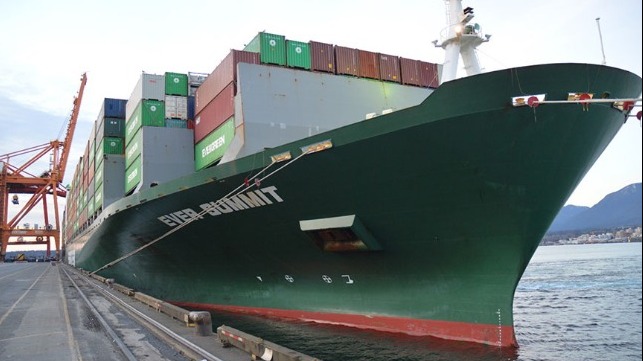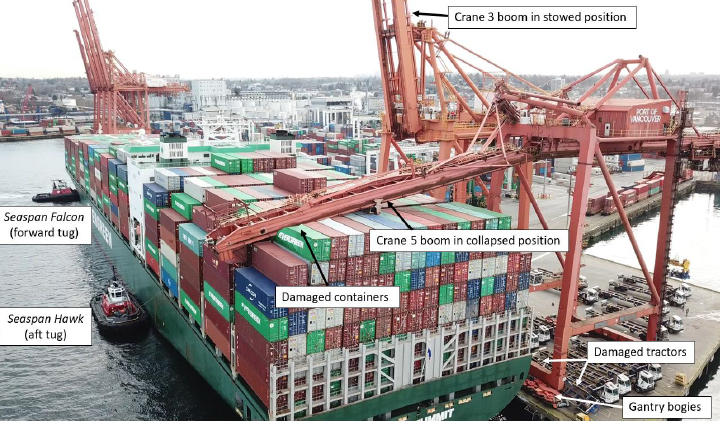TSB Canada Raises Vessel Size Concern in 2019 Vancouver Dock Incident

The Transportation Safety Board of Canada (TSB) issued a report into a 2019 containership accident in the Port of Vancouver highlighting concerns that the newer ships are outgrowing the current port infrastructure. While the investigation was looking at an incident when a container ship struck the berth causing a crane collapse, the board raised a concern relating to larger container vessels berthing at the Port of Vancouver and the capacity of existing terminal infrastructure to accommodate them safely.
The incident being investigated happened on January 28, 2019, when the 78,600 dwt Ever Summit operated by Evergreen Marine was berthing with a pilot aboard and being assisted by two tugs. At the time she was carrying 3,462 containers and she is rated for a capacity of 7,024 TEUs. During the maneuver, the vessel struck the berth and an adjacent shore gantry crane. After striking, the pilot ordered the engines and bow thruster stopped and instructed the tugs to reduce power to full stop. The pilot also ordered the vessel to drop its port anchor and instructed the tugs to hold the vessel in position.
As a result of striking the dock, the boom on the crane collapsed on top of the container stacks. Six boxes at the top of the stacks were damaged. In addition, there was a small puncture in the hull and the shell plating was pushed inward and dented.

From the report showing the damage during the berthing - courtesy of TSB Canada
The investigation found that the pilot’s and bridge team’s view of the tugs were obscured and that the pilot was relying on his memory and mental model of the maneuver to keep track of the location and movements of the tugs. Intending to move the bow of the vessel towards the berth by ordering the forward tug to push and the aft tug to pull, the tugs were inadvertently given opposite commands. As the tugs carried out the commands, the vessel’s stern rapidly moved towards the berth. Corrective action was ineffective, and the vessel’s stern struck the berth and crane.
The report says that the Ever Summit’s crew were relying on the pilot to maneuver the vessel safely to the berth, focusing primarily on monitoring the vessel’s position and carrying out the pilot’s orders and therefore not monitoring the pilot’s commands to the tugs. The report concludes if bridge teams do not maintain effective bridge resource management, including monitoring communications between pilots and tug masters, there is a risk that errors will go undetected. The investigation also found that procedures for tug use are largely left to the discretion of individual pilots and that no standard communication protocols were in place at the time of the occurrence.
In addition to looking at the individual incident, the report also details that over the past 10 years there has been a substantial increase in the size of container vessels worldwide, including those calling at the Port of Vancouver. Without upgrades to existing infrastructure, these larger vessels necessitate berthing maneuvers that have very little tolerance for error, says the TSB.
While all terminals are designed to accommodate a maximum vessel size and most have built-in safety margins, the report says there are currently no requirements for Transport Canada or a port authority to examine the suitability of a berth for larger vessels. Decisions as to maximum vessel size are left to the discretion of the individual terminals.
As the size of container vessels calling at the Port of Vancouver continues to increase and, given the absence of any oversight as to the suitability of the berths by Transport Canada or the Vancouver Fraser Port Authority, the Board is concerned that the size of vessels may exceed the Port of Vancouver’s terminal infrastructure capacity to accommodate them safely.

that matters most
Get the latest maritime news delivered to your inbox daily.
Following the occurrence, the British Columbia Coast Pilots reportedly developed standard operating procedures regarding tug communications during berthing and unberthing operations. The Port of Vancouver and the operator of the container terminal also reviewed their crane storage practices for arriving and departing container vessels.
The complete report is available online.
